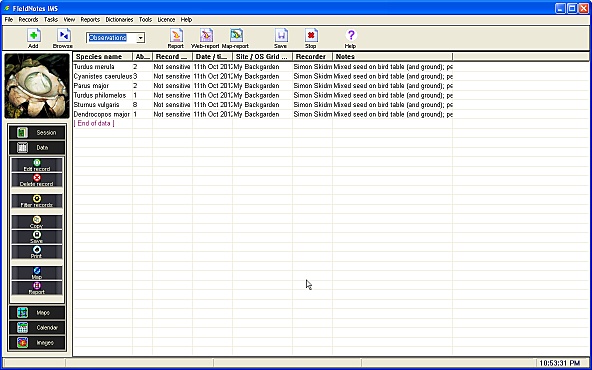Preliminary Steps in adding a number of Wildlife Observations (at a named Site)
Adding a number of new wildlife Observations to your database is a straightforward process that follows a similar format to entering a single Observation (Tutorial 2.3).
Open the 'New Observation' form
The quickest way of opening the 'New Observation' form is to ensure that the record-type selector is set to Observations, and select the Add button on the main toolbar.

Open the 'New Observation'
form by selecting:
Observations, then
the
Add button.
The 'New Observation' form is displayed, containing the fields used to record a new wildlife Observation.
Certain field values are initialised with values based on the current session.
The 'New Observation' form
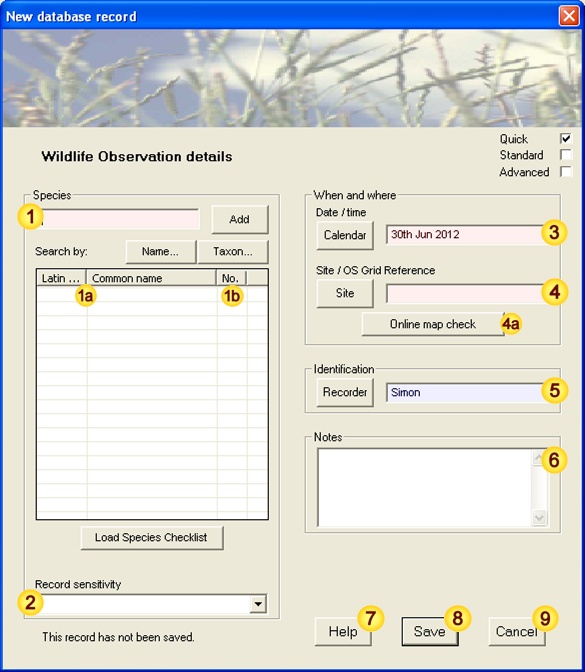 Input data fields
Input data fields
| Field | Notes |
| Species | Species name (common or latin name) |
| Species entry | (auto-generated from field ) |
| Abundance | No. of individuals seen |
| Record Sensitivity | Species Sensitivity assessment |
| Date / time | When the Observation was made |
| Location | Where the Observation was made |
| Recorder | Who made the Observation |
| Notes | Additional notes |
|
| Help | Field-content information |
| Save | Save data as new record |
| Cancel | Cancel the form |
Notes:
-
Mandatory fields (light red) are essential for creating a valid record.
-
Advisory fields (light blue) provide important or useful information for subsequent processing.
In general it is good practice to provide as much information (ie. complete as many fields) as possible.
Preliminary - check the level-of-detail
Check that the level-of-detail (displayed on the right-hand edge of the form title) is set to 'Quick'. If it is not, select the appropriate checkbox.

Setting the level-of-detail
checkbox to 'Quick'
[applies to most forms]
In this case level-of-detail affects the number of input fields displayed in a form.
The relevant Help library pages contain more detailed information about using level-of-detail.
Steps in adding a number of Wildlife Observations (at a named Site)
Sections 1-7 below describe the steps in completing the 'New Observation' form from scratch (in this case for multiple Observations at a named Site).
1. Select the relevant Species Checklist
We are going to use a checklist of the species most commonly seen at this site - in this case the 'Birds (garden top 20)' checklist which includes the most common species from the RSPB Garden Birds survey.
Any species that are not included in the checklist can be added manually to the 'New Observation' form.
Use the Load Species Checklist button (below the Species listbox) to view a list of available Checklists.
Selecting a Checklist:
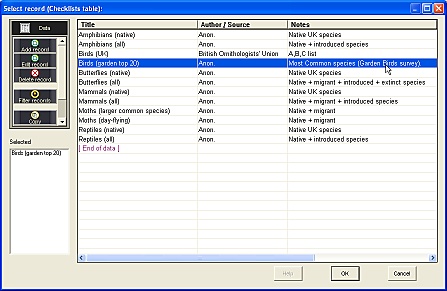
Select the 'Birds (garden top 20)' checklist (by double-clicking - this will add the name to the 'Selected' list on the left-hand side of the form), then use the OK button to load the checklist names into the Species listbox.
The twenty garden birds listed in the 'Birds (garden top 20)' checklist will be loaded into the species data list on the 'New Observation' form.
Selecting a Checklist:
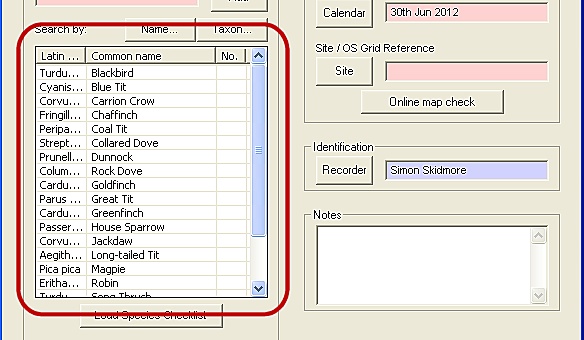
Note that when a checklist is used, abundance values are not preset to one (species with no abundance data are simply ignored during form-processing).
Using species Checklists
FieldNotes contains a number of pre-compiled checklists (eg. birds, mammals, reptiles, amphibians, butterflies, etc), which can be useful when recording a number of species at a single site, for example; timed counts, transects, trapping, water sampling etc.
You can easily create your own checklists for different sites by choosing the species that you see regularly - this process is described in a later tutorial.
Adding further Species by name
If your Observations include one or more species which are not included in the checklist, these can be added in the normal way - type the species name in the "Species" field.
After several letters have been entered, the auto-complete function will try to anticipate the species using the closest matching name from the Species database.

Enter the Common or Latin
name in the 'Species' field
Continue typing until the correct species name is displayed, then finish by pressing the Return key or use the adjacent Add button, either of which will add the species name to the end of the species-data list (below the entry field).

Species name added
to the Species-data list
Note that in this case an abundance of 1 (ie. single species observation) is automatically entered into the relevant column.
Enter number of individuals for each Species observed
When a checklist is loaded the abundance values are not automatically preset - this allows you to define the species that were actually observed by setting their abundance values.
It is not necessary to delete the names of species which were not observed, as any species with a missing abundance value will be ignored.
In the present case we need to set the abundance values for five of species observed (Greater Spotted Woodpecker is already set), by double-clicking on the appropriate column in the species-data list (column labelled 'No.' immediately right of 'Common Name') and entering the number of individuals observed.
Then either press the return key or click anywhere else on the form to enter this value.

Set the number of individuals
in the species-data list correctly.
Zero records
If '0' (zero) is entered for abundance, the record will
not be ignored, but will be stored as a 'zero' record.
Zero records are useful mainly when a species has been the focus of a survey and has not been found (ie. to determine areas in which it may be absent) and should not be used for everyday observations.
Assign a Sensitivity to these Records
In this case we would hope that these Observations will have a low sensitivity, as they relate to fairly common and widespread garden birds.
(Infact it will be evident from subsequent warnings that a number of these species are now of particular concern).

Setting record sensitivity.
Assessing Record Sensitivity - multiple observations
If just one or two of the species being recorded requires a higher sensitivity (for example, Song Thrush is now a BAP species), it is easier to use a Sensitivity value that applies to most of the species initially, and then edit the record(s) for more notable species (see
Tutorial 2.4 for a description of editing an existing record) and update the Record Sensitivity separately.
Enter the date when you made the observation
For convenience, the "Date" field is preset to the current date. If this is not the date when you made the observation, then correct the displayed date using either of the two following methods:
3(i). Simply delete the existing value in the "Date" field and type in the correct date (and time if required).

Updating the Observation
date directly
3(ii). Alternatively, press the adjacent Calendar button and select the correct date using the Calendar tool.
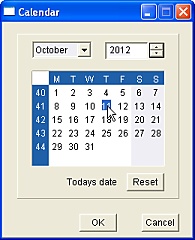
Selecting the
Observation date
using the Calendar tool
When you have chosen the appropriate day/month/year on the calendar, selecting OK will transfer the value into the relevant field on the 'New Observation' form.
Enter the location where you made this observation
In this tutorial we are going to use an existing Site (described in Tutorial 2.2) as the place where this observation was made.
To set this value correctly use either of the following methods:
4(i). Simply type the name of the relevant Site into the 'Location' field.

Add the Site name directly.
It is important that the name exactly matches the name of the relevant Site (differences in capitalisation are not important).
4(ii). Alternatively, use the Site button to view a list of sites entered into the database:
Selecting a Site from the list of site records:
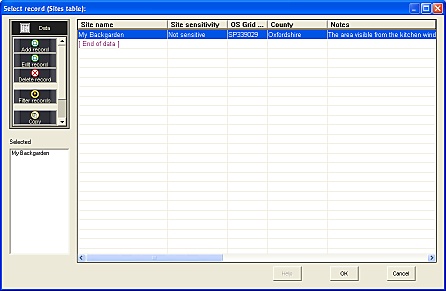
Pick the appropriate site name (by double-clicking - this will add the name to the 'Selected' list on the left-hand side of the form), then press the OK button to enter this value into the relevant field on the 'New Observation' form.
Using online maps to check a site location
Although the field entry refers to a Site record rather than an OS grid reference, the
Online map check button remains functional, extracting the relevant coordinate data from the Site record.
Confirm that the Recorder name is correct
For convenience, the "Recorder" field is preset with the current FieldNotes user.
However if this observation was made by someone else, their name should be entered in this field instead.
To update the field contents, either:
5(i). Simply delete the existing value and type in the name of the person who made this observation:

Update the Recorder
name directly.
5(ii). Alternatively, use the Recorder button to view a list of recorders entered into the database:
Selecting a Recorder from the list of recorder records:
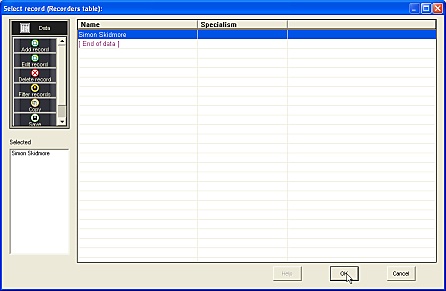
Select the appropriate recorder name (by double-clicking - this will add the name to the 'Selected' list on the left-hand side of the form), then press the OK button to enter this value into the relevant field on the 'New Observation' form.
Add relevant notes about this Observation
The 'Notes' field is free-text format - you may enter as little or much additional information as you like.
These notes will be included in the Observation record for each species, so you must ensure that they are generally applicable (ie. not specific behaviours).

Add relevant notes
for this Observation.
The 'Notes' field will automatically scroll to provide more space for your entry if required.
Alternatively double-click anywhere on the field to use a larger data-entry form.
Adding separate notes
If you wish to add separate notes for particular Observations, you will need to edit the relevant records (described in
Tutorial 2.4) and update the notes section separately.
Review the data you have entered
Take a moment to check that the data you have entered is correct, and agrees with your field notebook entry.
The 'New Observation' form - completed
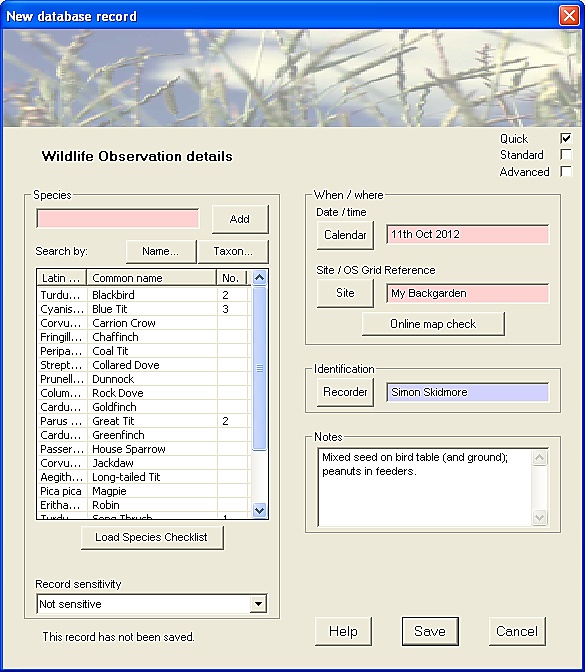
Field notebook entry
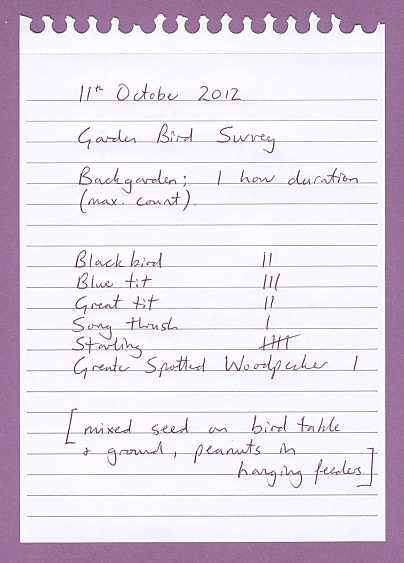
Its never too late to change your mind!
You may change any of the data you have entered in this record (or even delete it completely) later if you subsequently decide that it is incorrect, so saving the record is not a point of no return.
(Details of how to edit existing data are provided in a subsequent tutorial.)
If you are unsure about any of the data you have entered, the
Help button provides more information about acceptable field contents.
8. Save this record to the database
Pressing the Save button will save the information you have entered as a new database record.
Before the information is saved, however, FieldNotes will carry out a number of internal consistency checks on the values you have entered, and warn you if changes are required (eg. if the Observation date is invalid or ambiguous) or desirable (eg. if advisory fields that have not been completed).
Because data have been entered using a checklist (and abundance has not been entered for species which were not seen), we can expect the following warning message:
"<Abundance> value for one or more Species is missing - these records will be ignored."
This warning can be ignored, as this is the behaviour we require (see zero records note above).
Several other warnings are generated regarding record sensitivity;
"<Record Sensitivity> value is inconsistent with priority status of Turdus philomenos"
("This is a BAP Priority species - consider using "Maybe BAP priority species or higher)."
"<Record Sensitivity> value is inconsistent with priority status of Sturnus vulgaris"
("This is a BAP Priority species - consider using "Maybe BAP priority species or higher)."
Sadly, both species have suffered a significant reduction in numbers in many areas, and are now considered priority species.
However as the observations describe highly mobile species (birds), do not contain sensitive information (such as nesting sites) and occur within a private garden, the sensitivity value that we have used is reasonably valid.
Updating record sensitivity for Priority species
If you prefer to adjust the record sensitivity for one or two species in a checklist, you will need to edit the relevant records (described in
Tutorial 2.4) and update the Record Sensitivity section separately.
If additional error or warning messages are generated, you will have the opportunity to correct the values you have entered before the record is saved.
Your Observation information is now saved as a record in the database.
Later tutorials will show you how to create reports and plot maps based on your accumulated wildlife Observations.
Errors and Warnings generated by the 'New Observation' form
| Error / Warning Message |
Cause |
| Error | <Species> field must be given a value | The 'Species name' field has not been completed. |
| Error | <Date> field must be given a value | The 'Date' field has not been completed. |
| Error | <Location> field must be given a value | The 'Location' (OS grid reference) field has not been completed. |
| Error | <Date> invalid or ambiguous value | Date (and optionally time) has an invalid or ambiguous format. |
| Warning | <Record sensitivity> is inconsistent with the priority status of "species"
("species" is not a recognised Priority species.) | Record sensitivity may be set too high for this (non-priority) species. |
| Warning | <Record sensitivity> is inconsistent with the priority status of "species"
(This is a Priority Species - consider using "BAP priority species" or higher.) | Record sensitivity may be set too low for this (priority) species. |
| Warning | <Location> is not a valid Site name or OS Grid reference | The OS Grid reference value is not valid. |
| Warning | <Recorder> value does not match any existing records | The Recorder name does not match any Recorders in the FieldNotes database. |
See relevant sections above for details of valid values.
1. In some cases, a species cannot be uniquely identified from the species name that has been entered by the user. There are two main reasons for this:
-
Unrecognised Species names may occur as a result of mis-spelling the intended name, or from using an alternative (in some case local) name that is not included in the FieldNotes species database.
-
Unresolved Species names occur when two distinct species are commonly referred to by the same common name - for example, water boatman, cabbage white (where the common name may refer to several species); eyebright, hawkweed, bramble (where the common name is applied indiscriminately to a number of micro-species).
In both cases the relevant help topic provides guidance for establishing the correct species name.
Additional help topics describe techniques for Exploring the Species database and
Exploring the Taxon database, demonstrating alternative methods for uniquely identifying species.
To list the Observations made at this Site on a particular date ...
If you wish to view the wildlife Observations that you have recorded from this Site on a specific date:
Set the record-type selector (on the Toolbar) to Observations then select the Data taskbar button - a list of all Observations will be displayed in the data-view window.
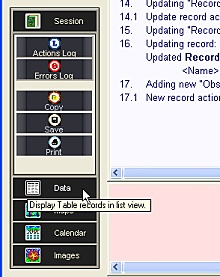
Select the
Data button
on the Taskbar (Data mode).
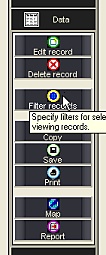
Select the
Filter records button
from the Data sub-tasks.
This will open the 'Data Filters' form.
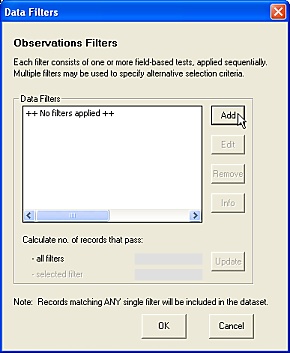
The 'Data Filters' dialog -
lists all filters applied to
Observations records.
Add a new filter
using the
Add button.
Adding a new 'Observations' filter (1)
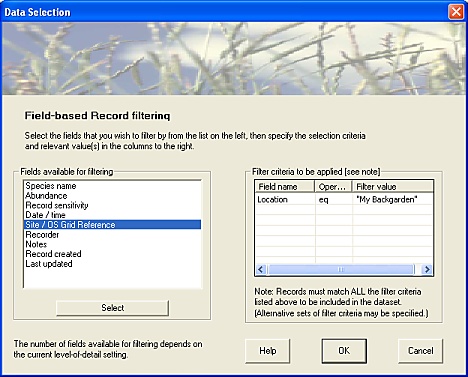
Specify the filter criteria:
-
select the relevant field (Site /OS Grid reference)
-
set the operator to 'eq' (equals) using the selector
-
set the filter value to 'My Backgarden'.
Adding a new 'Observations' filter (2)
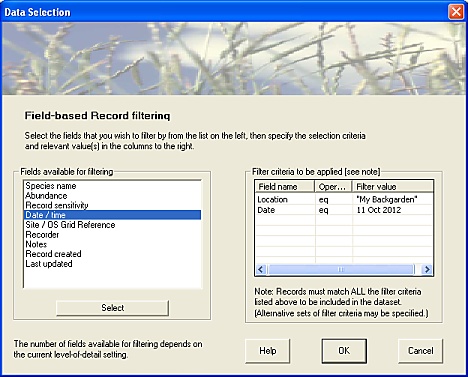
Specify the filter criteria:
-
select the relevant field (Date / time)
-
set the operator to 'eq' (equals) using the selector
-
set the filter value to the relevant date.
Select the OK button to end both the dialogs.
A list of all Observations associated with this Site is displayed in the data-view window.
The window may be scrolled up/down to view all records, and left/right to examine all fields for a specific record.
'Observations' records [Data view]
